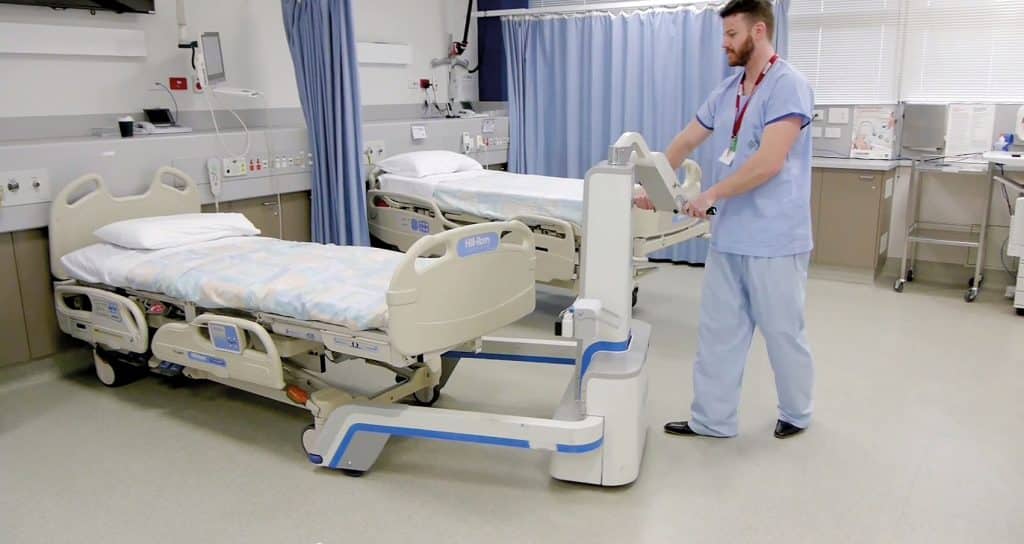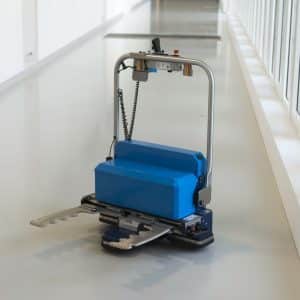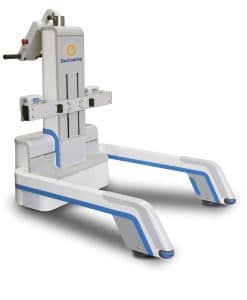Felgains GZS Bed Mover vs PTS P4 Multi Bed Mover; An Honest Comparison
When looking at implementing powered bed movers in your hospital to reduce the risk of musculoskeletal injury, you’re likely to come across multiple brands of bed movers on the market. The purpose of this article is to compare two of the most popular models; the PTS P4 Multi Bed Mover and the Felgains GZS Bed Mover.
In principle, these 2 bed movers achieve the same outcome; enabling your Portering team to safely move beds and stretchers over long distances, however, this article will dive deeper into the positives and drawbacks of each bed mover and reveal where they differ from each other.

What is the PTS P4 Multi Bed Mover?

The PTS P4 Bed Mover is designed and engineered to adapt to hospital beds and trolleys and motorise them without lifting, pushing or pulling optimising manoeuvrability, compatibility and flexibility. The PTS P4 attaches to beds and mattresses just above the castor wheels using a modular claw system and is controlled using a joystick.
Key Features of the PTS P4 Bed Mover
- 800kg safe working load (SWL)
- 360° rotation with remote control
- Powered steering, variable speed control, auto braking and emergency stop function as standard
- Unit attaches to bed or trolley in approximately ten seconds
- Compact, small footprint fits under bed or patient trolley
Key Benefits of the PTS P4 Bed Mover
- Compact design. The bulk of the PTS P4 bed mover goes underneath the bed, meaning the additional length it adds is minimal. Once you have finished using the PTS P4, the claws fold up for compact storage.
- Compatible with a large range of beds and stretchers. The PTS P4’s claw system is modular and subsequently can be fitted to a large number of beds and stretchers.
Drawbacks of the PTS P4 Bed Mover
- Joystick isn’t intuitive. Users of the PTS P4 bed mover report that the joystick is difficult to use, and not intuitive. This can result in the Portering team deciding not to use the equipment because they see it as a hassle and difficult to use.
- Requires modifying to suit different beds and stretchers. The downside to the bed mover being modular is that the porters may have to change the claw attachment multiple times throughout the day to be able to use it for each of your beds and stretchers.
What about the Felgains GZS Bed Mover?

The Felgains GZS Bed Mover is powerful enough to transport up to 600kg around the hospital, keeping portering and nursing staff safe from musculoskeletal injuries.
The GZS fits around your beds and stretchers, rather than underneath them, so no under-bed clearance is required. This enables the GZS to work with a wide range of hospital beds and stretchers.
Key Features of the GZS
- 600kg safe working load (SWL)
- Ergonomically adjustable handle position for comfortable use by all operators
- Automatic braking for safe operation on slopes or inclines
- 3-speed control, plus reverse and emergency stop
- Toolless attachment to the frames of beds and stretchers
Key Benefits of the GZS
- Very wide compatibility. Because the GZS requires no under-bed clearance and doesn’t rely on attachment to castor wheels, the GZS is compatible with the vast majority of hospital beds and stretchers, reducing the need for buying multiple pieces of equipment to suit the different beds in your trust. It also means the Portering team have a single go-to bed mover, rather than having to decide which bed mover to use for each bed or trolley.
- Compact design. The two arms of the GZS go underneath the main mattress platform, meaning no additional width is added to a standard hospital bed.
- Easy and intuitive to manoeuvre. The GZS is powered by wheels at the end of the two tines, making steering and manoeuvering a bed or stretcher much easier when compared to bed movers that are powered at the end of the bed, or via a joystick. This reduces the risk of the Portering team not using the product because it is difficult to use.
- Fast attachment to beds and stretchers. The GZS attaches to the main frame of a bed or stretcher using a toolless ratchet system, which allows porters to attach it to beds and stretchers more quickly compared to bed movers that attach to caster wheels or under the main structure.
Drawbacks of the GZS
- Slightly bulkier than the PTS P4. The GZS adds slightly more length to the equipment being moved when compared to the PTS P4, which could present challenges in narrow corridors or small lifts.
Which bed mover should you choose for your hospital?
Which bed mover you choose for your trust and hospitals will depend on your requirements and the hospitals you operate in, however, I trust this article has given you a good overview of the PTS P4 Multi Bed Mover and the Felgains GZS Bed Mover, and the positives and drawbacks of each.
Most hospitals would look to arrange a demonstration or trial of a bed mover before going ahead with a purchase, and this is something we are happy to arrange for you. Feel free to contact us on 01473 741144, or via the contact form below, to get the conversation started.
Related articles
Top 4 Drawbacks With Powered Bed Movers, With Solutions
The Best Powered Bed Movers For Hospitals In 2023
Get in touch
Got a question or want to send us a message? Let’s talk.